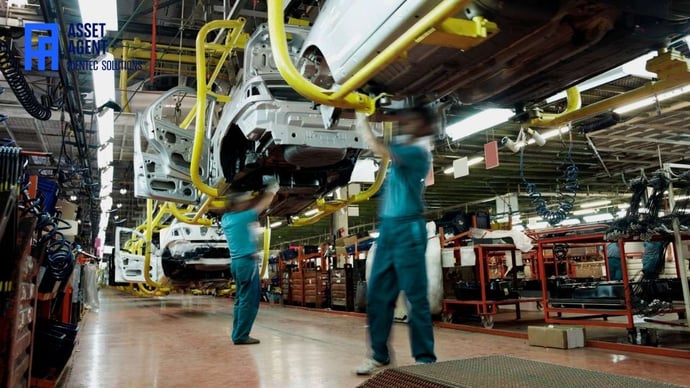Industry 4.0 Smart Factory: Operations and Business Potential
| Written by Mark Buzinkay
This article delves into what a smart factory is, how to adopt Industry 4.0 technologies and design the digital factory, and explores the potential of Operations 4.0 and the future of smart factories.
By the end of this article, you will have a comprehensive understanding of how to unlock the potential of a smart factory and thrive in Industry 4.0.

No video selected
Select a video type in the sidebar.
What is an industry 4.0 Smart Factory?
In recent years, the concept of Industry 4.0 has become increasingly popular in the business world. This term refers to the fourth industrial revolution, a period of increasing digitalization and automation that is revolutionizing the manufacturing industry. At its core, Industry 4.0 is about connecting digital systems with physical objects, creating a “smart factory” that can seamlessly leverage data and technologies to improve efficiency and operations.
A smart factory is a facility that uses both digital and physical systems to move from one state to another in order to produce a product. This is accomplished through the Internet of Things (IoT), artificial intelligence (AI), and robotics. By leveraging these technologies, a smart factory is able to monitor, control, and optimize its operations in real time.
In a typical smart factory, machines, robots, and other equipment are connected to a centralized system that is able to track and manage data across them. This system can detect when machines are not functioning correctly, identify opportunities for efficiency gains, and provide real-time feedback on production progress. In addition, a smart factory can utilize AI to identify new opportunities for innovation, such as new products or services that could be generated from its existing production data.
Do you want to learn more about why a legacy process may be a real challenge for improvement?
How Do you Develop A Business Model for Smart Factories?
In the modern business landscape, the development of the industry 4.0 smart factory is a fundamental step towards achieving greater productivity and leveraging advanced technology to facilitate the automation of processes, enhance operational efficiency, and enable informed decision-making. The potential of these smart factories is evident, but an effective business model must be developed to unlock their full business potential.
Developing an industry 4.0 smart factory business model requires a comprehensive strategy that addresses all aspects of the business, including value proposition, competitive advantage, and operational excellence. First, the value proposition identifies the unique value the factory offers customers, the competitive advantage defines how the factory will differentiate itself in the market, and operational excellence details how the factory can optimise its performance.
The value proposition for industry 4.0 smart factories is based on automated processes, the ability to reduce costs and enhance efficiency, and improved customer service enabled by the technology. These factors will enable the smart factory to differentiate itself from other industry competitors and establish a competitive advantage.
Regarding operational excellence, industry 4.0 smart factories must have an effective and efficient supply chain management system. This should include developing an intelligent inventory control system and a streamlined order-fulfilment process. Additionally, the factory should leverage predictive analytics and other data-driven technologies to optimise production operations and improve the quality of products and services.
Finally, a comprehensive communication and collaboration platform should be developed to ensure the success of the industry 4.0 smart factory. This platform should enable data and systems integration and facilitate information sharing in real time. By creating an effective communication infrastructure, the smart factory can more effectively leverage its technologies, reduce costs, and increase efficiency.
Learn more about RTLS tags and factory efficiency.
Adopting Industry 4.0 Technologies
Industry 4.0 is a term used to describe the introduction of smart, technology-enabled manufacturing processes. Smart factories utilize the latest technological advances, such as the Internet of Things (IoT), artificial intelligence (AI), machine learning, and big data, to increase efficiency, reduce production costs, and improve product quality.
Traditional factories often struggle to keep up with the fast-paced demands of modern business due to the high costs associated with implementing necessary changes. However, the adoption of Industry 4.0 technologies can significantly reduce these expenses and enable businesses to become more agile and adaptable to change.
Smart factories, powered by Industry 4.0 technologies, enable businesses to gain greater visibility, reduce physical workforce demands, automate production processes, and increase output. Additionally, machines can digitally communicate with each other and the business to identify potential issues before they become critical. All of these advances allow businesses to become more agile and stay ahead of the competition.
To truly unlock the potential of industry smart factories, businesses must invest in the latest technologies and properly integrate them into their existing processes. This requires companies to have a comprehensive data strategy in place that is capable of collecting, analyzing, and acting upon the data generated. Ultimately, adopting Industry 4.0 technologies is necessary for businesses to realize the full potential of smart factories and stay competitive in today’s rapidly changing market.
Read on to learn more about the challenges of digital transformation for manufacturing.
Benefits of Operations 4.0 for Businesses
One of the major benefits of Industry 4.0 operations is scalability. This is particularly evident when it comes to product development, new markets, and additional services. Rather than investing heavily in hardware improvements, businesses can adopt simple methods to upgrade their operations. Similarly, enhancing customer service traditionally requires more personnel, but by utilizing terminals, bots, self-service solutions, and automated processes, businesses can provide better services around the clock and save resources as the system can scale up without recurring additional costs. Furthermore, operational platform solutions can be deployed universally, making it easier to capitalize on growth opportunities without the need for high investments in infrastructure, including hiring a competent workforce.
The maybe most obvious benefit of Operations 4.0 is its cost savings. Automated machines require considerably less energy and maintenance than traditional operations. This can lead to considerable cost savings for businesses, especially when paired with automation's increased productivity. Additionally, businesses will be able to produce and dispatch higher volumes of goods than ever quickly.
Smart factories also give businesses greater visibility over their operations. By monitoring operations in real time, businesses will benefit from having up-to-date information about their production processes and inventory levels. This will reduce losses due to inefficient operations and improve overall profitability.
Implementing Industry 4.0 smart factory technologies will also help businesses become more agile. Automation makes it easier to adapt to changing customer needs and respond quickly to the marketplace. Additionally, the technology allows businesses to optimize their production processes and quality assurance measures, leading to safer and more reliable products.
In addition, Operations 4.0 offers businesses a variety of advantages related to data. Data can be collected and analyzed in real time, allowing businesses to gain insights into their operations and customer needs. This data can be used to identify areas of improvement and innovate more quickly.
The Future of the industry 4.0 Smart Factory
The potential of smart factories is seemingly limitless, yet the full impact of Industry 4.0 is yet to be truly seen. Industry 4.0 is a term coined to describe the fourth industrial revolution, which combines automation and data to revolutionize production and value chains. Smart factories are powered by invaluable data, analytics, and automation tools that allow them to be more efficient, cost-effective, and responsive than ever before.
A 2022 survey revealed that 72% of companies were in the process of implementing their Industry 4.0 or Smart Factory strategies, with many initiatives underway and some already completed. This reflects a substantial increase from previous years, highlighting the accelerating integration of advanced digital technologies in manufacturing and other sectors. (2)
The future of industry smart factories lies in their ability to continually innovate and produce higher quality products faster and more economically. This is achieved through combining the latest technologies, such as artificial intelligence (AI), the internet of things (IoT), computer vision, and robotics.
AI is becoming an increasingly essential component of smart factories, enabling machines to accurately identify patterns and recommend changes that could result in increased production efficiency. IoT devices allow machines to communicate with one another, making it easier for machines to respond to environmental changes and optimize their operations. Computer vision allows machines to accurately identify objects and sizes, enabling robots to function more efficiently and reliably. Robotics will continue to play an integral role in smart factories, allowing them to perform complex tasks that would otherwise be impossible.
In the future, smart factories will be able to respond quickly and accurately to ever-changing customer demands while ensuring that processes remain compliant with changing regulations. Production capacity will increase, waste will be reduced, and machines will become increasingly efficient. Smart factories will also be able to predict better and prevent malfunctions, enabling them to run with fewer interruptions and reduce downtime.
Smart factories of the future will continue to develop with the introduction of new and innovative technologies. As the need for increased efficiency, accuracy, and responsiveness increases, so too will the importance of smart factories in the manufacturing industry. Read more about the future factory!
Real-Time Production Visibility
Real time production visibility is key to unlocking the business potential of Industry 4.0 smart factories. By leveraging cutting-edge digital technologies, smart factories can now provide granular, real-time visibility into their production process. This technology gives factory owners and managers visibility into the production line's performance, with the ability to monitor, measure, and adjust the process as needed. This visibility enables factory owners to identify and prioritise any issues, adjust production schedules, and manage resources more efficiently. Through real-time visibility, smart factories help uncover new optimisation opportunities across the entire value chain, reducing costs and improving efficiencies.
However, Industry 4.0 smart factories heavily rely on sensors and actuators to maximise efficiency and optimise resources. Sensors detect and monitor information within the factory environment, while actuators regulate the physical environment based on collected data. Together, they form the cornerstone of a successful smart factory (learn more about how to implement real time locating systems).
Sensors record information about production processes, employee and customer interactions, environmental conditions, and more. They detect changes within the factory and capture vital information, such as temperature, pressure, movement, and more. This data quickly assesses current conditions and makes accurate decisions.
Actuators respond to sensor signals and make physical changes based on the collected data. Examples of actuated components include valves, pumps, motors, switches, and more. By leveraging the data collected by the sensors, the actuators can regulate the environment and ensure that production runs smoothly.
The sensors and actuators must be accurately calibrated and connected to a quality control system for a successful smart factory. This system should be able to accurately measure and analyse the data collected by the sensors, and the actuators should be able to respond to the signals from the quality control system.
Ultimately, sensors and actuators are essential for the Industry 4.0 smart factory. By leveraging the power of data collection and automation, smart factories can maximise efficiency and optimise resources for guaranteed success.
FAQs Industry 4.0 Smart Factory
What is an Industry 4.0 Smart Factory?
An Industry 4.0 Smart Factory is a highly digitized and automated manufacturing facility that leverages technologies such as the Internet of Things (IoT), artificial intelligence (AI), and robotics to monitor, control, and optimize production processes in real time. These factories integrate digital systems with physical objects, enabling enhanced efficiency, reduced costs, and improved production quality.
How do smart factories differ from traditional factories?
Smart factories differ from traditional factories by utilizing advanced technologies like IoT, AI, and robotics. These technologies allow machines and systems to communicate and make decisions autonomously, providing real-time data analysis and optimization. This results in greater efficiency, reduced human intervention, and the ability to quickly adapt to changes in production requirements.
What are the key components of a smart factory?
The key components of a smart factory include sensors, actuators, AI, IoT devices, robotics, and centralized control systems. Sensors collect real-time data, actuators make physical adjustments based on this data, and AI algorithms analyze and optimize the overall production process. These elements work together to create a seamless and efficient manufacturing environment.
What role do sensors and actuators play in a smart factory?
Sensors and actuators are essential components of a smart factory. Sensors collect data on various aspects of the production process, such as temperature, pressure, and movement. This data is then analyzed to optimize production. Actuators, in turn, respond to this data by making physical adjustments, such as controlling machinery or adjusting environmental conditions, to ensure that the production process runs smoothly and efficiently.
Takeaway
Smart Factories offer a wealth of opportunities to companies that want to stay competitive in the ever-changing digital landscape. With the right infrastructure, businesses can leverage the latest Industry 4.0 technologies and techniques to significantly increase their efficiency and profitability. Smart Factories provide a platform on which businesses can build strong and durable digital factories and processes that enable them to reduce their dependence on manual labour and increase their utilization of emerging technologies such as sensors, actuators, and machine learning (learn about retrofitting brownfield operations). Additionally, smart factories can enable real-time production visibility, allowing businesses to make informed decisions faster and more accurately than ever before. As the technologies and tools needed for Smart Factories become cheaper and more accessible, many more companies are likely to join the bandwagon, ushering in an age of enhanced automation and productivity.
Dive into one of our core topics: Real time location systems
Glossary
A business model defines how an organization creates, delivers, and captures value. It outlines revenue streams, cost structures, target customers, and key activities. Common models include subscription, freemium, marketplace, and direct sales. A well-structured business model enhances competitiveness and sustainability by aligning resources with market needs. Innovation in business models drives growth, particularly in digital and platform-based economies. (3)
Sources:
(1) Lucas Santos Dalenogare, Guilherme Brittes Benitez, Néstor Fabián Ayala, Alejandro Germán Frank,
The expected contribution of Industry 4.0 technologies for industrial performance, International Journal of Production Economics, Volume 204, 2018, Pages 383-394, ISSN 0925-5273, https://doi.org/10.1016/j.ijpe.2018.08.019.
(2) https://iot-analytics.com/industry-4-0-in-5-stats/
(3) Osterwalder, A., & Pigneur, Y. (2010). Business Model Generation: A Handbook for Visionaries, Game Changers, and Challengers. Wiley.
Note: This article was updated on the 12th of February 2025

Author
Mark Buzinkay, Head of Marketing
Mark Buzinkay holds a PhD in Virtual Anthropology, a Master in Business Administration (Telecommunications Mgmt), a Master of Science in Information Management and a Master of Arts in History, Sociology and Philosophy. Mark spent most of his professional career developing and creating business ideas - from a marketing, organisational and process point of view. He is fascinated by the digital transformation of industries, especially manufacturing and logistics. Mark writes mainly about Industry 4.0, maritime logistics, process and change management, innovations onshore and offshore, and the digital transformation in general.





